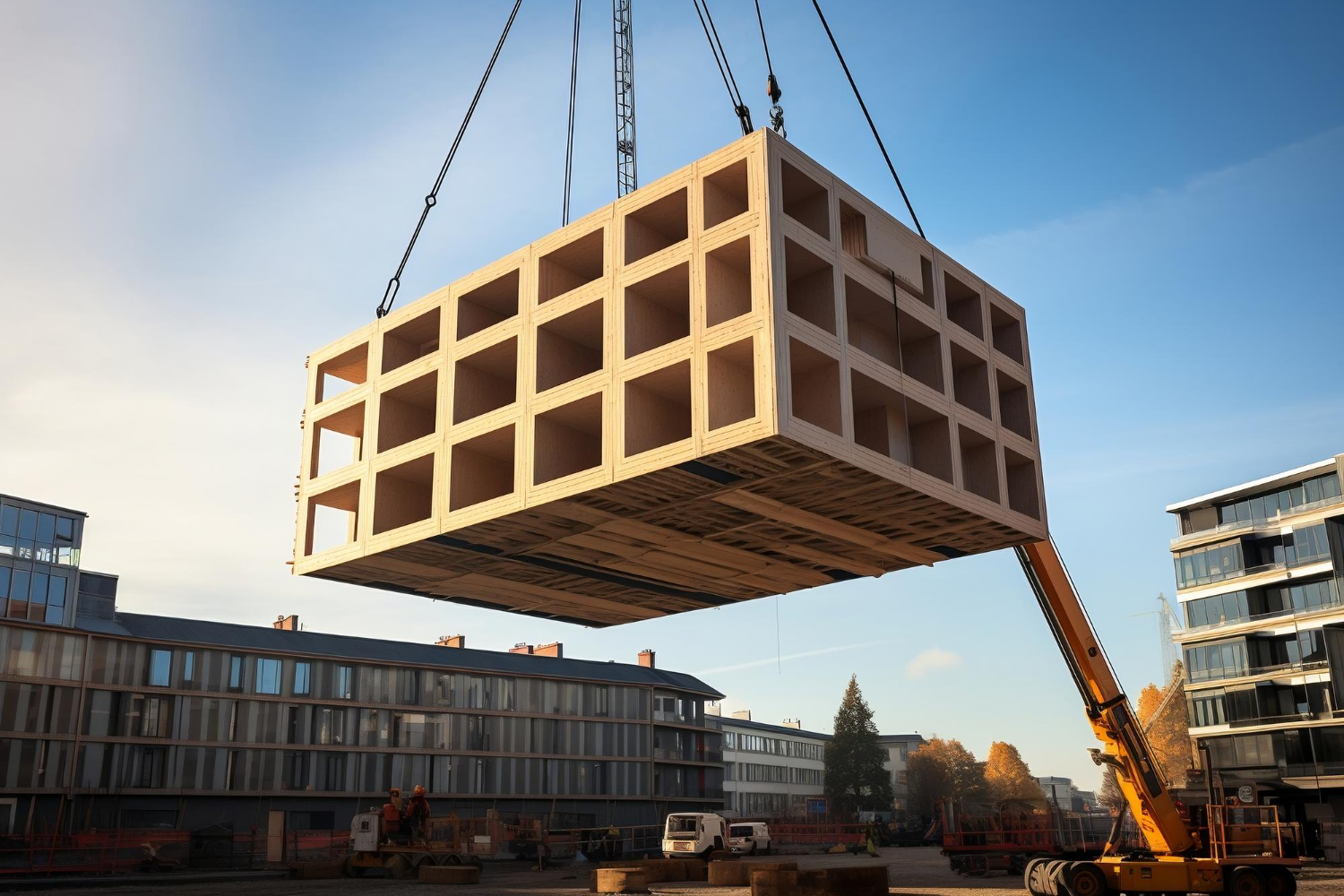2025 is a turning point for the construction industry- as rising labor shortages, increasing pressure to build sustainably, and growing demand for fast delivery- are pushing project managers to rethink traditional methods. That’s where modular construction enters the spotlight! People may sometimes confuse prefab with modular- prefab is any building component made off-site, while modular is a type of prefab where entire 3D sections or modules of a building are constructed in a factory and then assembled on-site.
Modular offers speed, cost savings, sustainability and quality in one go- exactly why everyone is talking about modular in 2025! In this blog, we will dive into the benefits of modular construction that have not only increased its adoption but also promise it as the future of building!

Unpacking the Core Advantages of Modular Building
1. Accelerated Project Timelines and Faster Occupancy
One of the biggest advantages of modular construction is speed. This is because modules are manufactured offsite in factories while site work and foundations happen simultaneously.
According to the Modular Building Institute1, projects can be completed 30–50% faster than traditional builds as a result of this parallel process. This means tenants, owners, and investors start seeing returns much sooner. At the same time, one must also remember that modular is also not as simple as dropping in a house and calling it done. Getting the set up still requires cranes, truck access, and coordination between crews for finishing work. But, with good management- overall speed and costs fall in the favour of project managers.
The traditional “site-built” method, on the other hand, is sequential in nature- implying that the site preparation must finish before the construction starts. This obviously leads to delayed occupancy when compared to modular construction.
2. Significant Cost Savings and Enhanced Budget Predictability
You might ask: Is modular construction cheaper?
A report2 by McKinsey highlighted that modular can reduce total construction costs by up to 20%. But that’s not sufficient reason to believe. Logically put, while upfront material costs may appear to be similar, in the overall project- the time savings, reduced labor needs, and fewer delays lead to lower total expenses. Prefabrication in modular mode also offers better budget predictability by minimizing weather-related risks and onsite labor overruns.
3. Superior Quality Control and Consistent Craftsmanship
Reddit users in their candid conversations have often noted that modular homes have better finishes than stick-built homes- thanks to the repeated uniform factory precision. Modules are factory-built and hence undergo strict quality assurance processes.
Controlled environments minimize defects, delays, and rework- while precision tools ensure consistent craftsmanship across units.
4. Unlocking Environmental Sustainability and Reduced Waste
Modular construction also offers environmental benefits. One, standardized factory processes optimize material use, cutting waste by up to 90% compared to onsite methods. Two, reduced transportation of materials and fewer onsite activities also lower the project’s carbon footprint.
Besides, if you opt for sustainable modular homes, they also integrate green technologies like energy-efficient systems and recyclable materials. This sustainability factor turns modular into a greener future-ready choice.
5. Enhanced Safety and Reduced Noise
Safety is another key advantage of modular construction approach- as most work happens in controlled factory environments, GCs simply skip the hazards of onsite construction. Shorter onsite activity reduces community disruption, noise and traffic. This factor makes modular construction particularly attractive for urban infill projects and healthcare facilities.
6. Design Flexibility and Customization Potential
A lot of people visualize modular construction with cookie-clutter, however, contrary to this misconception, prefabricated systems allow for custom layouts and finishes. From hotels to hospitals to schools, advanced design software used for modular easily adapts to diverse needs. Due to this, 61%3 of developers planned to employ full volumetric modular methods in at least 10% of their projects between 2020-2023- according to a report by Dodge Construction Network.
On the downside, customization is also often limited to the manufacturer’s catalogue. Changing floor plans, window placements, or roof lines can get expensive fast—or just not be possible with modular. With stick-built, there’s more freedom to adjust things mid-construction, though it also opens the door to budget creep and delays.
Modular vs. Traditional: A Comparative Overview
Addressing Common Concerns: Drawbacks and Considerations
While modular offers the above benefits, there are certain factors which hold contractors from switching:
- Moving modules, especially in remote locations can add transportation expenses.
- Perception of modular with investors and lenders is taking time to appreciate.
- Complex, one-off architectural forms may be harder to achieve with modular.
These barriers are however shrinking as the market is maturing in 2025. Improved logistics network, wider lender acceptance and advanced modular design software are rapidly addressing these limitations.
Why Now? The Driving Forces Behind Modular Adoption in 2025
Like we saw at the beginning of this blog, several conditions play out to make 2025 the tipping point for modular construction:
Shortage of skilled labor: Skilled labor gaps continue to delay traditional builds.
Demand for speed: Businesses need faster occupancy to maximize returns.
Pressure to be sustainable: Governments and investors increasingly demand greener building practices.
Breakthrough of technology: AI-powered design, factory digital twins 4, and advanced prefab manufacturing are making modular smarter and more efficient than ever.
According to Verified Market Reports5, modular construction market size is expected to reach USD 295.4 Billion by 2033 at a CAGR of 9.3% from 2026 to 2033.
Depending on whether the modular construction project requires custom, project-specific modules or standardized modules, precise takeoffs become important for the prefab manufacturer or for the estimator respectively.
In the first case, the prefabricator needs detailed takeoffs to determine the exact material quantities, structural requirements, and finishes inside each module. A precise material quantity takeoff at this stage ensures correct module-material quantity, and that the modules are manufactured to precise specifications, fit the site, and integrate correctly with MEP systems. Here, the interior material quantities of the modules are covered by the prefab manufacturer, but site-related and integration quantities (like concrete, rebar, and MEP connections) still require takeoffs by estimators.
In the second case, modular manufacturers have pre-designed, standard module sizes for walls, rooms, or units. The estimator selects from these prebuilt sizes, and the prefabricator can produce quickly without custom takeoffs. Takeoffs for these modules are mainly used by the estimators to calculate quantities, site foundations, tie-ins, and logistics, rather than for module design.
In short, takeoffs are crucial for estimators to plan, select, and integrate standardized modules efficiently, and for prefabricators to design and manufacture custom modules accurately. With material takeoff software, you get material quantities ready to use without spending hours counting. AI handles the takeoffs automatically, and a human review makes sure nothing’s missed.
Ready to Build Smarter? Next Steps in Your Modular Journey
If you’re a GC firm or a SC considering modular construction, you still need detailed takeoffs for concrete, rebar, structural steel, grading, utilities, and connections, since those are built on-site to support the modules. Takeoffs are also required to quantify the tie-ins- mechanical, electrical, plumbing, fire protection- to connect factory-made modules seamlessly once delivered. Let’s understand tie-ins briefly:
Tie-ins are the connections made on-site to integrate the prefabricated modules with each other and with the building’s core systems. For example:
- Plumbing tie-ins → To connect factory-installed bathroom/kitchen piping inside the module to the site’s main water supply and drainage.
- Electrical tie-ins → To link the module’s prewired circuits to the site’s electrical panels and grid.
- HVAC tie-ins → To join ductwork or refrigerant lines from the module to the central HVAC or rooftop units.
- Structural tie-ins → To fasten modules together and anchor them to the foundation or structural frame.
So even if modules arrive “nearly finished,” these tie-in works are critical for making the whole building function as one system. Thinking about modular construction? AI-based takeoffs make it easier; connect with us to find out more.

.png)







.png)
.jpg)


.png)

.webp)

